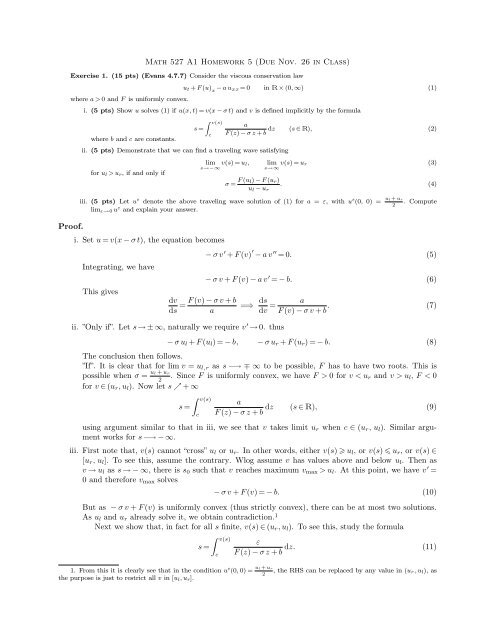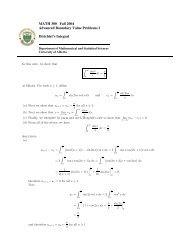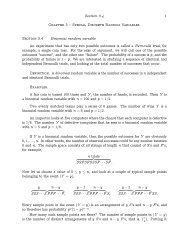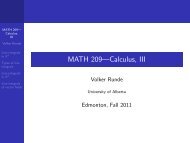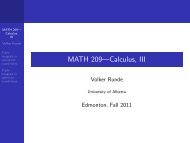Math 527 A1 Homework 5 (Due Nov. 26 in Class) Proof. i. Set u = v(x ...
Math 527 A1 Homework 5 (Due Nov. 26 in Class) Proof. i. Set u = v(x ...
Math 527 A1 Homework 5 (Due Nov. 26 in Class) Proof. i. Set u = v(x ...
You also want an ePaper? Increase the reach of your titles
YUMPU automatically turns print PDFs into web optimized ePapers that Google loves.
<strong>Math</strong> <strong>527</strong> <strong>A1</strong> <strong>Homework</strong> 5 (<strong>Due</strong> <strong>Nov</strong>. <strong>26</strong> <strong>in</strong> <strong>Class</strong>)<br />
Exercise 1. (15 pts) (Evans 4.7.7) Consider the viscous conservation law<br />
where a >0 and F is uniformly convex.<br />
<strong>Proof</strong>.<br />
ut + F(u) x − a uxx = 0 <strong>in</strong> R × (0, ∞) (1)<br />
i. (5 pts) Show u solves (1) if u(x, t)=v(x − σ t) and v is def<strong>in</strong>ed implicitly by the formula<br />
where b and c are constants.<br />
ii. (5 pts) Demonstrate that we can f<strong>in</strong>d a travel<strong>in</strong>g wave satisfy<strong>in</strong>g<br />
for ul > ur, if and only if<br />
� v(s) a<br />
s =<br />
dz (s ∈ R), (2)<br />
c F(z) − σ z + b<br />
lim<br />
s→−∞ v(s) = ul, lim v(s) = ur<br />
(3)<br />
s→∞<br />
σ = F(ul) − F(ur)<br />
. (4)<br />
ul − ur<br />
iii. (5 pts) Let uε denote the above travel<strong>in</strong>g wave solution of (1) for a = ε, with uε (0, 0) =<br />
limε→0 uε and expla<strong>in</strong> your answer.<br />
i. <strong>Set</strong> u =v(x − σt), the equation becomes<br />
Integrat<strong>in</strong>g, we have<br />
This gives<br />
dv F(v) − σv + b<br />
=<br />
ds a<br />
ii. ”Only if”. Let s → ± ∞, naturally we require v ′ → 0. thus<br />
ul + ur<br />
. Compute<br />
2<br />
− σv ′ + F(v) ′ − a v ′′ =0. (5)<br />
−σv + F(v) − a v ′ = − b. (6)<br />
ds<br />
dv =<br />
a<br />
. (7)<br />
F(v) −σv + b<br />
−σul +F(ul)=−b, − σur +F(ur) = − b. (8)<br />
The conclusion then follows.<br />
”If”. It is clear that for lim v = ul,r as s ∓ ∞ to be possible, F has to have two roots. This is<br />
ul + ur<br />
possible when σ = . S<strong>in</strong>ce F is uniformly convex, we have F > 0 for v < ur and v > ul, F < 0<br />
2<br />
for v ∈ (ur, ul). Now let s ր + ∞<br />
� v(s)<br />
a<br />
s =<br />
dz (s ∈ R), (9)<br />
F(z) −σz + b<br />
c<br />
us<strong>in</strong>g argument similar to that <strong>in</strong> iii, we see that v takes limit ur when c ∈ (ur, ul). Similar argument<br />
works for s − ∞.<br />
iii. First note that, v(s) cannot “cross” ul or ur. In other words, either v(s) � ul, or v(s) � ur, or v(s) ∈<br />
[ur, ul]. To see this, assume the contrary. Wlog assume v has values above and below ul. Then as<br />
v → ul as s → − ∞, there is s0 such that v reaches maximum vmax > ul. At this po<strong>in</strong>t, we have v ′ =<br />
0 and therefore vmax solves<br />
−σv + F(v)=−b. (10)<br />
But as − σ v + F(v) is uniformly convex (thus strictly convex), there can be at most two solutions.<br />
As ul and ur already solve it, we obta<strong>in</strong> contradiction. 1<br />
Next we show that, <strong>in</strong> fact for all s f<strong>in</strong>ite, v(s) ∈(ur, ul). To see this, study the formula<br />
�<br />
s =<br />
c<br />
v(s)<br />
ε<br />
dz. (11)<br />
F(z) − σz +b<br />
1. From this it is clearly see that <strong>in</strong> the condition uε (0, 0) = ul+ur<br />
, the RHS can be replaced by any value <strong>in</strong> (ur, ul), as<br />
2<br />
the purpose is just to restrict all v <strong>in</strong> [ul, ur].
As F is strictly convex, the behavior of the denom<strong>in</strong>ator close to ul and ur is like (z − z0) −1 . And<br />
thus if v(s)=ul or ur, necessarily s = ∓ ∞.<br />
F<strong>in</strong>ally, fix any s 0 f<strong>in</strong>ite, we have<br />
s<br />
ε =<br />
�<br />
c<br />
v(s)<br />
1<br />
dz. (12)<br />
F(z) − σ z + b<br />
When ε ց 0, the LHS → ∓ ∞, consequently v(s) → ul or ur. Thus we see that as ε ց 0, v ε converges<br />
to v at every s 0. �<br />
Exercise 2. (5 pts) (5.10.3) Denote by U the open square � x ∈ R2N|x1| < 1, |x2| < 1 � . Def<strong>in</strong>e<br />
⎧<br />
⎪⎨<br />
1 − x1 x1 > 0, |x2| < x1<br />
1 + x1 x1 < 0, |x2| < − x1<br />
u(x) =<br />
. (13)<br />
1 − x2 x2 > 0, |x1| < x2<br />
⎪⎩ 1 + x2 x2 < 0, |x1| < − x2<br />
For which 1 �p �∞ does u belong to W 1,p (U)?<br />
Solution. First we can easily check that u ∈ C � Ū � and is smooth <strong>in</strong>side each triangle. If we def<strong>in</strong>e v<br />
piecewisely such that v = Du <strong>in</strong> each triangle, it is clear that v ∈W 1,p for any p. Now what is left to show<br />
is that v = Du <strong>in</strong> U.<br />
1 Take any φ ∈C0(U). Denote by Ui, i=1, , 4, the triangles. We have<br />
�<br />
v φ=<br />
U<br />
�<br />
�<br />
Duφ=−<br />
Ui i<br />
�<br />
�<br />
u Dφ+<br />
i<br />
�<br />
�<br />
niuφ. (14)<br />
∂Ui i<br />
As u is cont<strong>in</strong>uous across any common boundary of any two Ui’s, and φ = 0 on ∂U, the boundary terms<br />
sum up to 0.<br />
�<br />
Exercise 3. (10 pts) (5.10.14) Verify that if n > 1, the unbounded function u = loglog 1 + 1<br />
�<br />
belongs to W<br />
|x|<br />
1,n (U),<br />
for U = B0 (0,1).<br />
<strong>Proof</strong>. Compute<br />
Thus we have<br />
Now we have<br />
�<br />
<strong>Set</strong>t<strong>in</strong>g z = log<br />
�<br />
B(0,1)<br />
1+ 1<br />
�<br />
, we have<br />
r<br />
�<br />
Du =<br />
B(0,1)<br />
1<br />
�<br />
log 1 + 1<br />
|x|<br />
|Du| � C<br />
�<br />
1<br />
1 + 1<br />
�<br />
−<br />
|x|<br />
x<br />
|x| 3<br />
�<br />
1<br />
�<br />
log 1+ 1<br />
|x|<br />
|Du| n � 1<br />
dx � C<br />
0<br />
�<br />
log<br />
(15)<br />
� 1<br />
. (16)<br />
|x|<br />
1<br />
1+ 1<br />
r<br />
� n<br />
1<br />
dr (17)<br />
r<br />
|Du| n � ∞<br />
1<br />
dx�C dz < + ∞ (18)<br />
log2 zn when n >1. �


